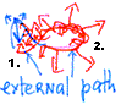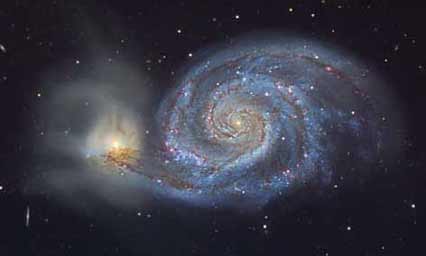Wave Theory approaches time in a strikingly unique manner, but does not necessarily contradict the outlooks posited by the major theories. My notion of time is based on the premise that time and space are produced wherever energetic matter appears and that these three entities only exist within the structure of the wave formation. In other words, energy, time, and space are entities in their own right and not merely units of measurement.
Albert Einstein — by dint of his ingenious intuition —introduced time as the fourth dimension. However, Wave Theory claims that time cannot exist on its own, and therefore Einstein's additional dimension must be comprised of time, energy, and space. None of the three components can exist without the other two. Furthermore, the existence of time is entirely dependent on the occurrence of an event, as without the presence of an energetic activity, time is useless. Energetic activity must similarly occur within the realm of a particular area (space) and time.
The entire notion that energy, time, and space are veritable entities
derives from none other than Einstein's famous equation:
![]() e
= mc2
e
= mc2
I tinkered around with this equation before finally arriving at the obvious variation:
![]() m
= e/c2
m
= e/c2
This version clearly proves that matter is virtual, since the building blocks of matter — energy, space, and time — are intangible. Many observations of natural phenomena have subsequently bolstered this idea (see Gravitation). As a result of these findings, I introduced the wave formation as an alignment within which energetic matter can function in the manifold ways that are evident throughout the natural world and universe. These observations show that energetic matter moves like a propeller, advancing forward in a swirling, coil-like motion. The forward and swirling movements are aligned in a constant state of superposition (a concept developed by Erwin Schrödinger).
 |
 |
 |
Max Planck, of course, produced the quant theory, which introduces quants
as the basic units of every entity in  our
universe. Wave Theory contends that all quants must contain units of energy,
time, and space. Moreover, quants are wave formations (see Introduction)
that are comprised of two swirls (loops/helices): an energetic, horizontal
Kerr swirl and a magnetic, vertical Schwarzchild swirl. At first, Planck
was unable to explain the existence of the energetic component because
the gravitational component is dominant, but he finally completed his
theory by dint of his famous equations. Erwin Heisenberg subsequently
developed this idea further with his Uncertainty Principle. By proving
the existence of the energetic loop (adjacent illustration), Wave Theory
provides considerable support to Heisenberg's Principle.
our
universe. Wave Theory contends that all quants must contain units of energy,
time, and space. Moreover, quants are wave formations (see Introduction)
that are comprised of two swirls (loops/helices): an energetic, horizontal
Kerr swirl and a magnetic, vertical Schwarzchild swirl. At first, Planck
was unable to explain the existence of the energetic component because
the gravitational component is dominant, but he finally completed his
theory by dint of his famous equations. Erwin Heisenberg subsequently
developed this idea further with his Uncertainty Principle. By proving
the existence of the energetic loop (adjacent illustration), Wave Theory
provides considerable support to Heisenberg's Principle.
Since waves are only configured as circles, space and time must also resemble what Einstein termed as "curved space" (picture below).

M51 Courtesy of NASA
It is accepted that energetic matter passes from one wave formation to the next by either connections that resemble molecule receptors or by phase transitions. Energetic matter (time, space, and energy) is transferred in a hierarchical system in which larger units of energetic matter attract smaller units and together preserve the hierarchal system of the universe. Every formation eventually dissembles; the energetic matter is released and proceeds via other phase transitions to other formations where they once again gather in the dispersed matter and create new wave formations. Units of time, aligned in waves of manifold sizes, are formed in an array of different-sized waves that are connected to energy and space. This then corresponds with Einstein's idea of relative time, as wave theory shows that his idea of relativity applies to the various sizes of the wave formations. Moreover, by means of phase transition and wave hierarchy, all energetic matter and units of time adhere to absolute time. These ingenuous formations then explain how time, energy, and space have neither a beginning nor an end. Instead, they are woven together as per Isaac Newton's notion of absolute time. In other words, it is the different quants that are comprised of energetic matter that co-exist on different time planes, while the entire formation operates within the confines of absolute time. Consequently, both Newton and Einstein were correct!
Different "Times"
By studying the behavior of different units of time, we can determine
the particular phase transition that a wave formation is in, as well as
other details. Wave theory's notion of time implies that when a wave loses
energy it rotates at a quicker pace, and time is thus condensed. For example,
a magnetic star that has lost its energetic loop (highly energetic matter)
rotates faster and thus time also elapses at a quicker pace. This can
be expressed in the form an equation:
| Time = | energetic
space |
|
oscillation
rate |
Even after being dispersed, energetic wave formations (quants) retain their genes, which possess all the information that pertains to time and other related data. As I explained in my article Backward Time, units of time ultimately return to their source. However, the unit/quant obviously undergoes significant changes and it retains all the components and properties that it has picked up along the way.
My Equation of Low Phase Transitions depicts the manner in which time is bent at a quicker rate when energy escapes from wave formations:
E(x) |
= 1 | |
M |
The E signifies the amount of energy in the energetic loop, M signifies the magnetic loop, and x denotes the number of rotations. This is especially prominent in wave formations that are located in extremely concentrated spaces and contain dominant magnetic components with a high capacity for energy. The equation also shows how an energetic wave that loses energy from its energetic loop rotates at a quicker pace within an abridged time frame. This course of events enables the wave to maintain its equilibrium despite the loss of energy.
Although it has taken some 100 years, Wave Theory has finally vindicated Einstein's notion of relativity in a manner that does not contradict Newton's brilliant idea of absolute time. Nevertheless, much work remains to be done on the subject of time and I too continue to research this exhilarating field.
- end -
Dr. Chaim Tejman, Copyright© 2004. All rights reserved.